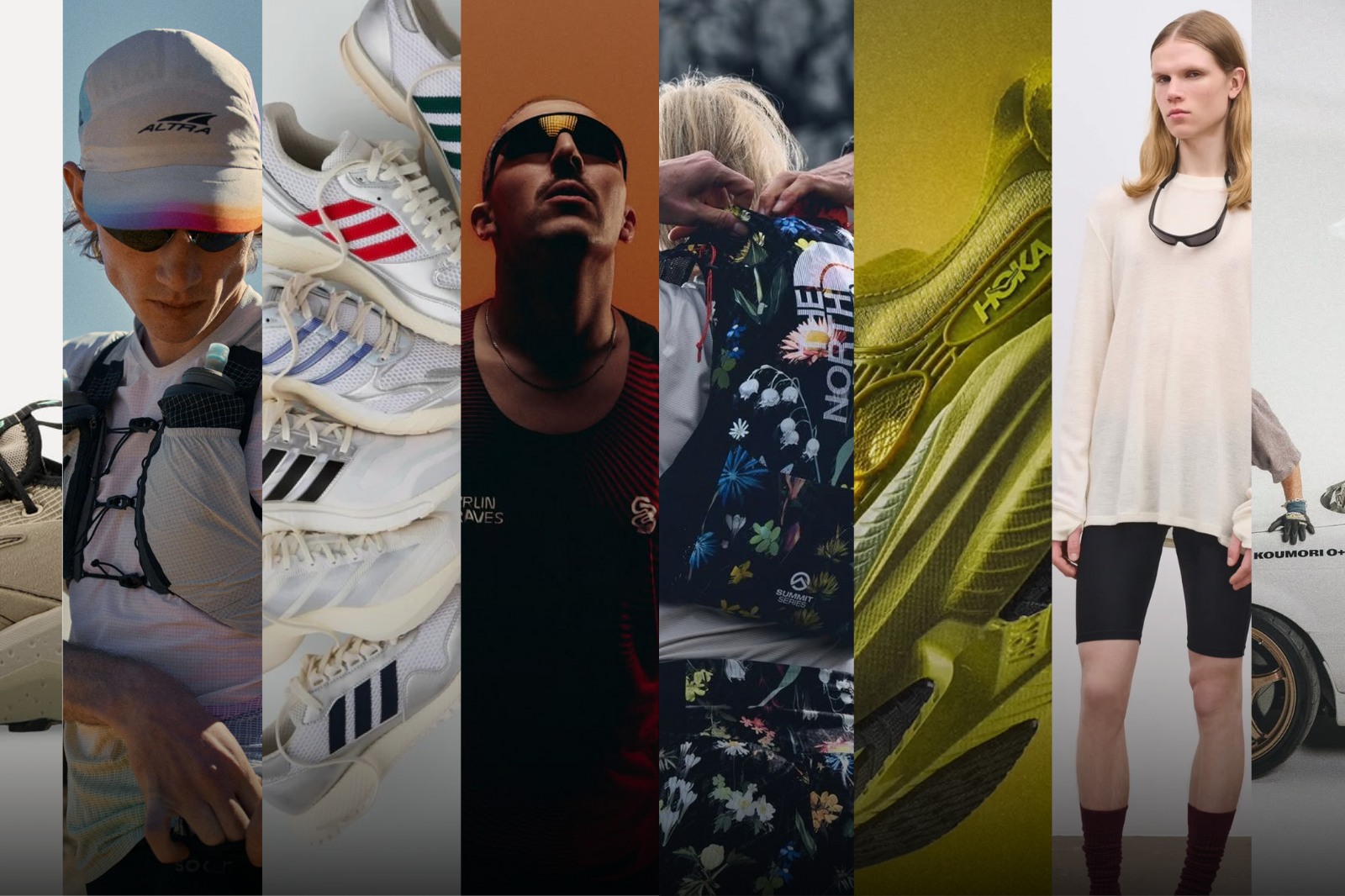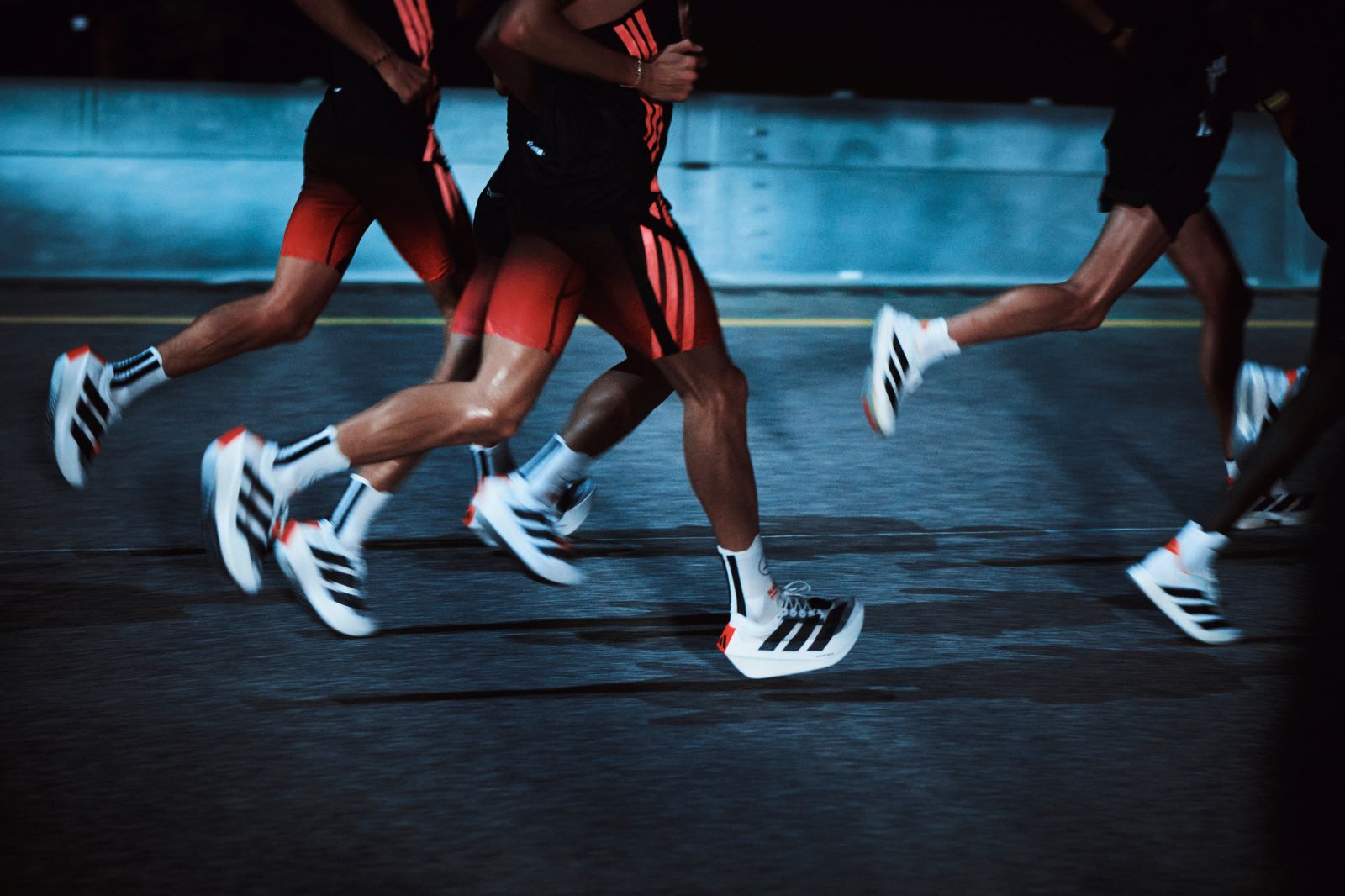
We independently review everything we recommend. When you buy through our links, we may earn a commission.
Chasing 100, an attempt to break the 100K world record at the Nórd Ring test track in Italy
All-new Adidas Adizero Evo Prime X, Climacool jacket with interior fan system, all-new race singlet, ice vest with individual ice chambers
Aleksandr Sorokin (Lithuania), Jo Fukuda (Japan), Charlie Lawrence (USA), Ketema Negasa (Ethiopia), Sibusiso Kubheka (South Africa)
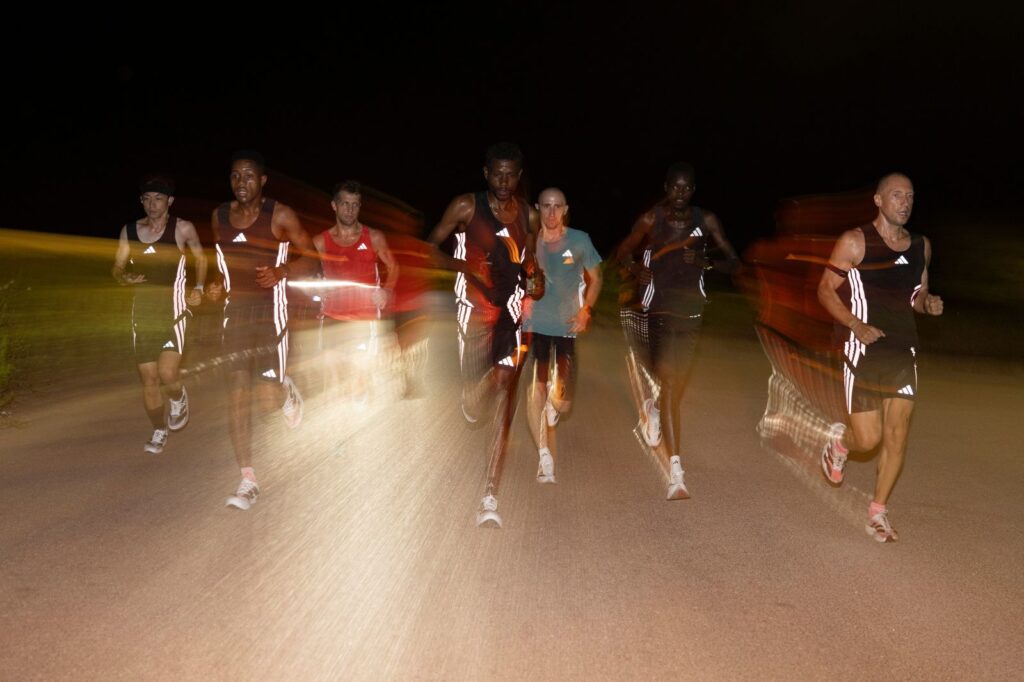
Photo courtesy of Adidas
On August 20, Adidas announced that five of its athletes would attempt to run a 100K distance in under 6 hours, an unofficial world record supported by a whole range of unseen innovations, including an all-new super shoe. The event would take place at Nardó Ring, a circular high-speed test track in southern Italy just inland from the coast, a legendary location known for long-distance speed records in the auto racing world.
Adidas called upon five athletes to take on the task: current 100K world record-holder Aleksandr Sorokin (Lithuania), Jo Fukuda (Japan), Charlie Lawrence (USA), Ketema Negasa (Ethiopia), and Sibusiso Kubheka (South Africa). When the dust settled six days later at 6 a.m. local time, only three of them finished the race and broke the Sorokin’s previous world record (6:05). But one stood alone. That morning, as a fiery red sunrise bathed the track in early light, Sibusiso Kubheka made history by running 100 kilometers in 5:59:20, becoming the first human to ever break the six-hour mark for the distance.
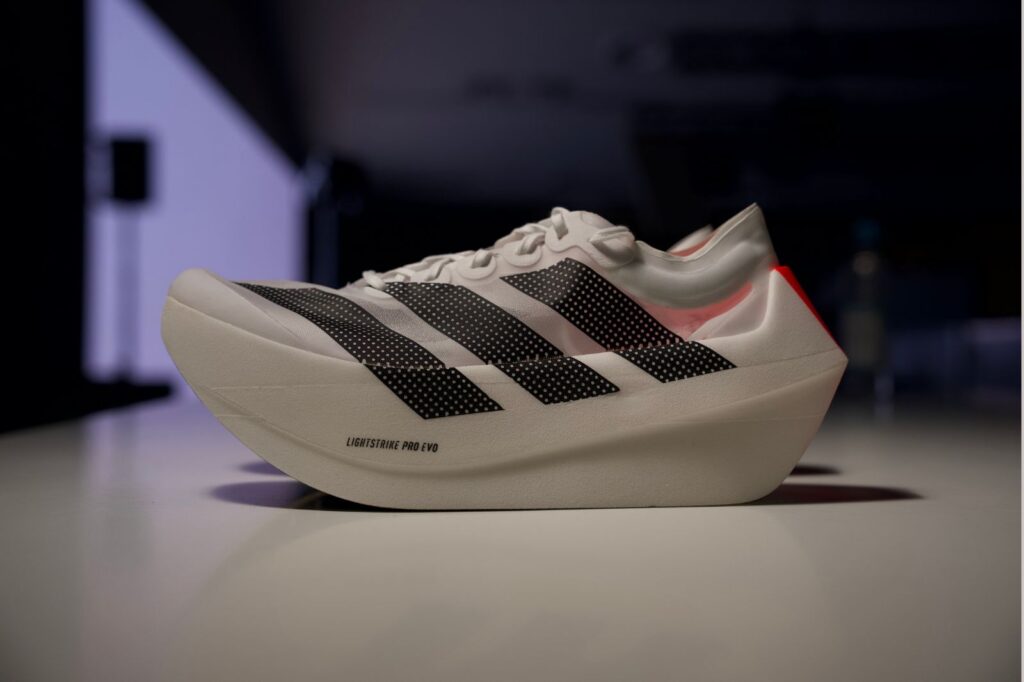
The all-new Adidas Adizero Evo Prime X (photo courtesy of Adidas)
The road to this record was not an easy one. Adidas kept most information very secretive; even upon my arrival, I knew almost nothing about the attempt itself or the technologies, apparel, and footwear that would be used. But as we entered the test rack and the midnight start drew closer, everything began to make sense. I then realized that this was, in fact, a bigger challenge than expected.
Here is the story as it unfolded.
The project started only six months ago, when Mercedes-AMG, the Formula 1 team, decided to break some records using an electric car. They chose the racetrack in Nardó, Italy, a common testing ground for fast driving. Adidas, as the official partner of the F1 team, seized the opportunity to join AMG by attempting to set a record of their own in the same location. And so, Chasing 100 was born.

The all-new Adidas Adizero Evo Prime X (photo courtesy of Adidas)
Typically, when attempting to break a record, a brand would set out to find ideal conditions for the runners. However, the location was already predetermined, presenting many challenges. The first being the heat, as the Nardó track is located right next to the sea in southern Italy. In the summer, normal temperatures range around 113°F with high humidity.
To solve the problem, Adidas decided to attempt the record at night; however, the track is situated within a natural area with no artificial lighting. Providing illumination for the athletes during the six-hour race was the next challenge.
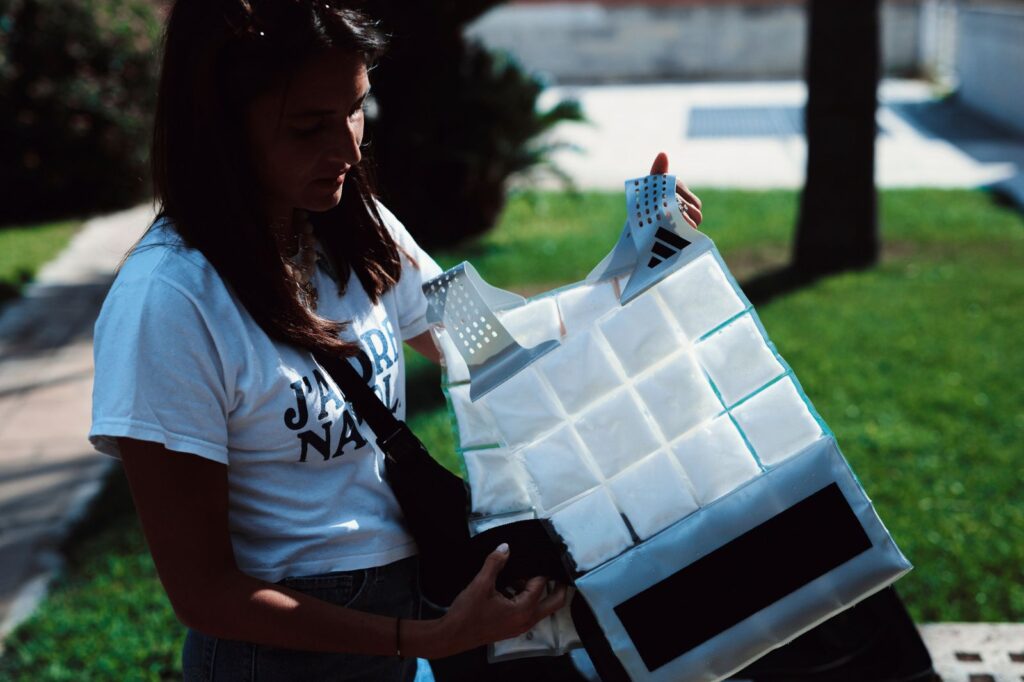
Ice vest used by the athletes pre-race (photo courtesy of Adidas)
On my way from the airport to my hotel, I received a call. Change of destination: Let’s go to another town and meet the athletes. When I arrived, I sat down to talk with Jo Fukuda, Aleksandr Sorokin, and Charlie Lawrence. Each of them has a distinct aura, each providing insights into their nutrition, preparation, and expectations.
The first thing that shocked me is that none of them had ever been to the track and will not do so until the race starts. Another topic is the slight tilt of the track, a banked design that’s perfect for cars, but not great for long-distance running.
“I go to sleep about 5 a.m. until 10 or 12, then I eat, run, sleep an hour, run again. Now my biggest chunk of running is between 10 p.m. and 4 a.m.” – Aleksandr Sorokin
“Instead of once a week, I did sauna four to five times a week, plus sweatsuit runs. Frying myself on purpose. Tomorrow it’s boring food: basic turkey sandwich, avocado — stuff I know sits well.” – Charli Lawrence
“I ran about 4,000 kilometers since April as preparation for this event. For me, here the weather feels tender compared to Thailand and Japan.” – Jo Fukuda
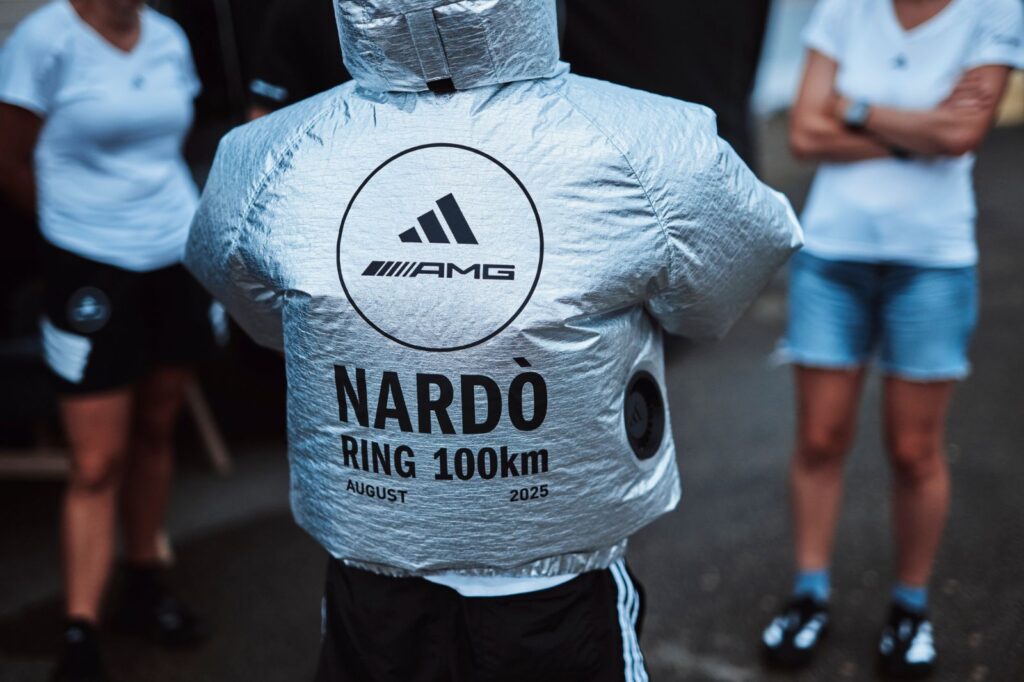
Climacool jacket with built in fans (photo courtesy of Adidas)
In regards to footwear, the spotlight is on the Adizero Evo Prime X, an all-new, super-stacked shoe created specifically for this attempt, boasting more foam than shoe but slick as a racing car. You can read all about it here. The TLDR is that it’s an ultra high stack race day shoe (~50 mm of stack height), utilizing the same uncompressed foam technology found in the Adizero Pro Evo 2. There’s one other thing– in the 24 hours leading up to the race, Adidas placed each athlete’s shoes in an individualized compression canister (or, Ultracharge in Adi terms), tuned specifically to each athlete’s preferred underfoot feel. Placebo effect or sound science, who’s to say, but it’s pretty interesting either way.
Unfortunately, Adidas only brought the shoes for the athletes. All of them were either too big or too small for me to try on. Bummer.
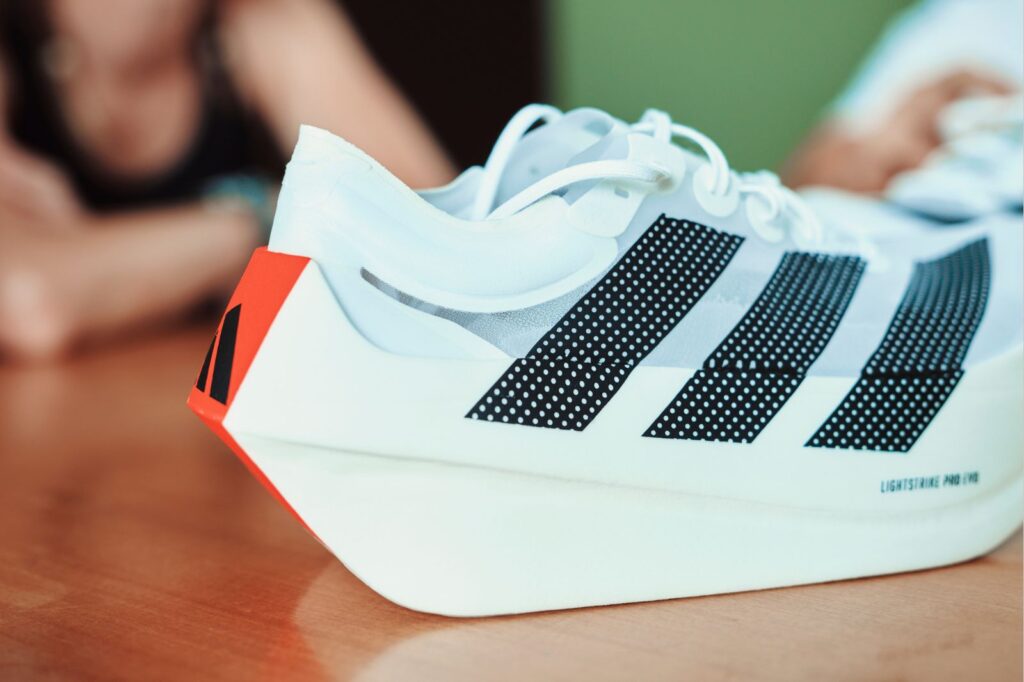
Heel of the Adidas Adizero Evo Prime X (photo courtesy of Adidas)
The newest and most eye-raising component of the Adizero Prime X was the utilization of individual, pressurized vaults designed to “supercharge” the athletes’ shoes. I was able to see this in person, right before an impromptu run around the block with Aleksandr Sorokin as I tried out a new ice vest Adidas created to combat the heat. The vest would be worn pre-race by the athletes, along with the CLIMACOOL jacket. The insulation jacket features two fans inside that inflate the garment, which, combined with the ice vest, creates a personal air conditioning system. The objective is to lower the temperature of the torso as much as possible before the start.
For the race, a new singlet with embossed material was developed. The idea is that the embossed fabric pulls the sweat away from the skin, making it easier to dry. Out of all the new tech, this is probably the only thing the average person will be able to buy in the near future. It looked incredibly rad, I wanted to steal one but I refrained.
“Normally, shoe development works in five-month cycles—design, test, revise. For this project, we did three full cycles in five months. Feedback was sent to the factory by Friday, and prototypes were ready Monday.” – Harry Miles, Director of Footwear Innovation
On the morning of the race, we visited the Nardó track to take a closer look and hear from the people behind all the product innovations.
Since a lot of secret car testing is done at the location, the security is extremely tight. We were required to complete a mandatory online training session before arrival. We received our badges to enter the area and our phone cameras were covered with stickers. There was security watching over at all times to ensure we didn’t enter the wrong places. This was not Adidas’ request, but the regular Nardó protocol.
We entered the area, drove past some garages, a gas station, and then followed a police car onto a dirt road. I felt like I was on my way to interview a drug lord in his hidden compound. We finally arrived at a section of the track where Adidas had set up camp.
After the product briefing and a look at the special pace car for the race, I returned to the hotel to take a nap for a few hours. The race was set to start at midnight, and I hadn’t been awake from 12:00 to 06:00 am in a very long time.
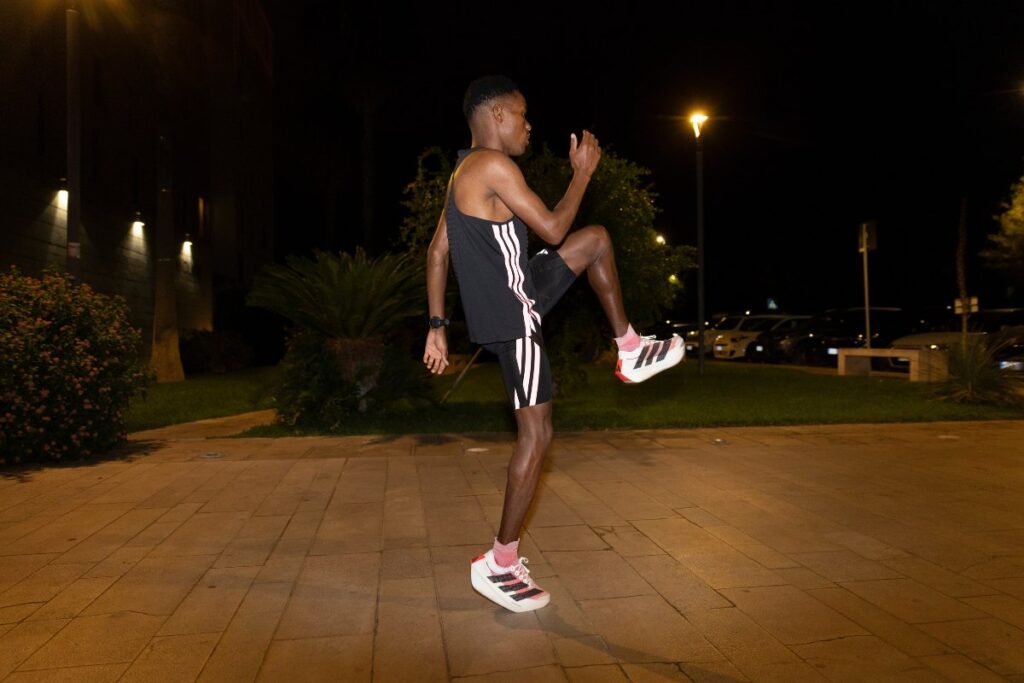
Sibusiso Kubheka warming up (photo courtesy of Adidas)
As night fell and moved forward, they called me back inside the Nardó track at around 11 pm, just before the start of the race. The temperature was still high, especially for a 6-hour race, sitting around 71F (22 Celsius). There were no red carpets, big LED screens, or VIP sections. I was offered the option to take a nap either inside a car or on an inflatable bed.
At this point, it all becomes crystal clear to me: This isn’t a publicity stunt; this is primarily an R&D project for Adidas. They went full hackathon mode for 5 months, and this right here is their final leap into the unknown, literally a run into darkness.
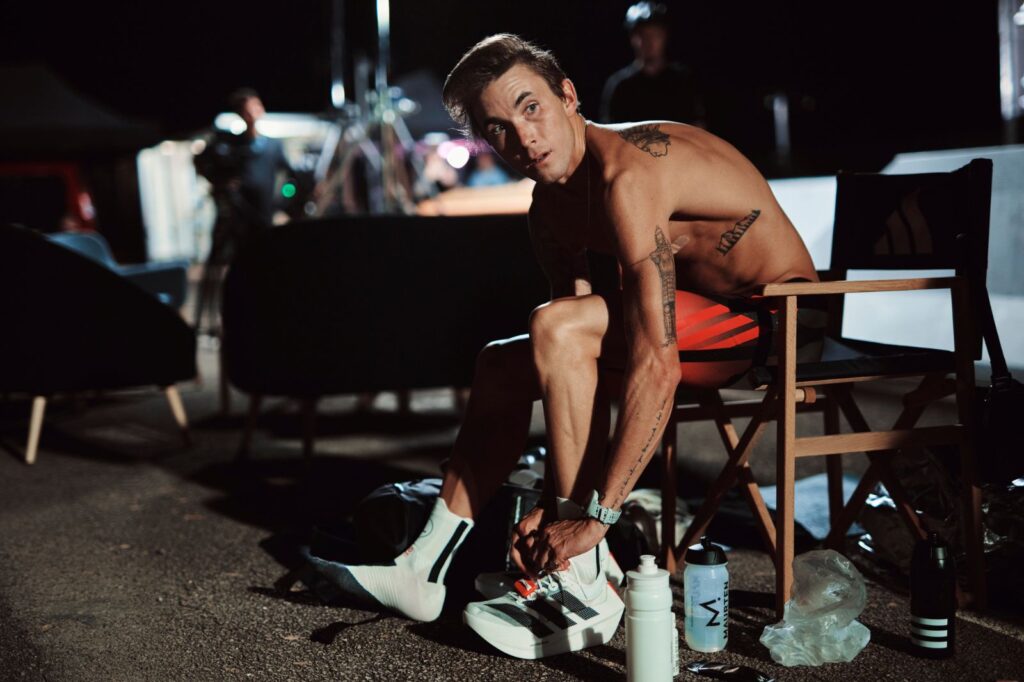
Charlie Lawrence lacing up the Evo Prime X (photo courtesy of Adidas)
I looked around and realized I was the only running media present to witness this event. Nearly every person surrounding me were here to work; there were no spectators, no livestream, and no speeches. Everyone was focused on the goal: to complete 100 kilometers in under 6 hours.
Because of this unique situation, I was able to walk around the athletes as they got ready, zipped up their Climacool jackets, strapped on their ice vests, zipped open their Climacool jackets, removed their ice vests, warmed up their legs, and laced up their shoes. At that point, the rules loosened up. I was also able to take my phone out (carefully), and I take a few videos.
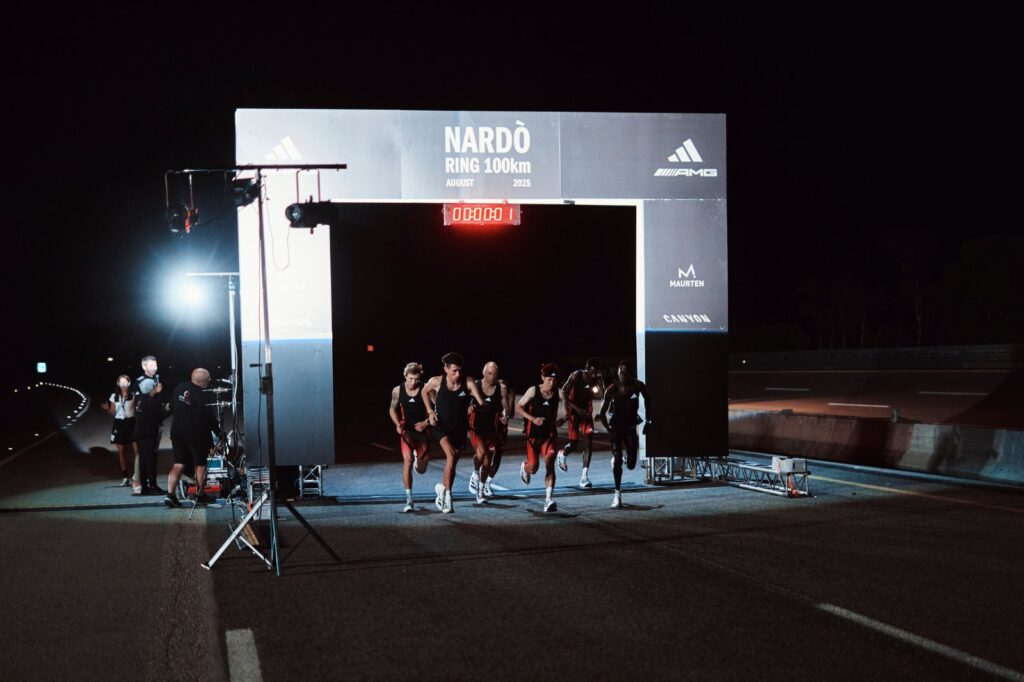
And they’re off, into the night (photo courtesy of Adidas)
At kilometer 62, Ketema Negasa drops out of the race. The car brings him into the pit stop. Everyone is quiet, trying not to look. Giving him space.
A little after kilometer 70, Jo Fukuda drops out too. Someone on his team tells me that he started to experience blurry vision, and perhaps not enough hydration. So even though he did not want to stop, he had to.
The hard part starts now. Aleksandr Sorokin is already running shirtless. Two more laps to go.
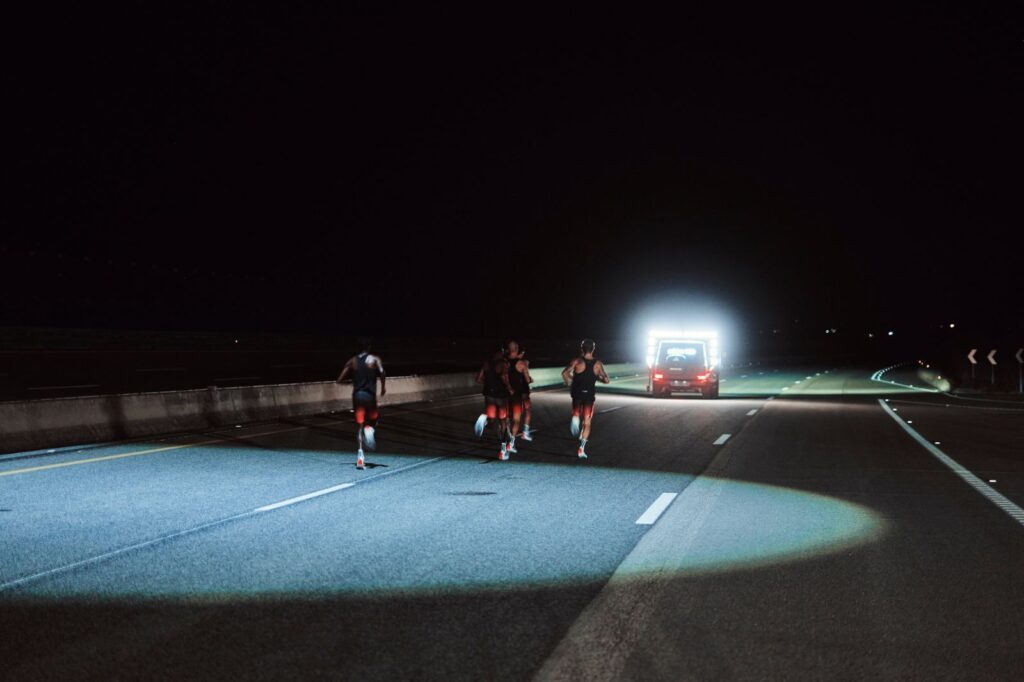
The track illuminated by rear facing lights on the lead car and headlights of rear car (photo courtesy of Adidas)
The separation is clear. Sibusiso Kubheka at the front, followed by Charlie Lawrence and Aleks Sorokin. They passed us for the final lap, the last 12k. The sun started to rise, which meant there was no longer a need for the tail car’s beam of light. Everyone was anxious. I spotted the VP of Innovation trying to remain calm, but he was clearly on the edge of his seat. Would they make it?
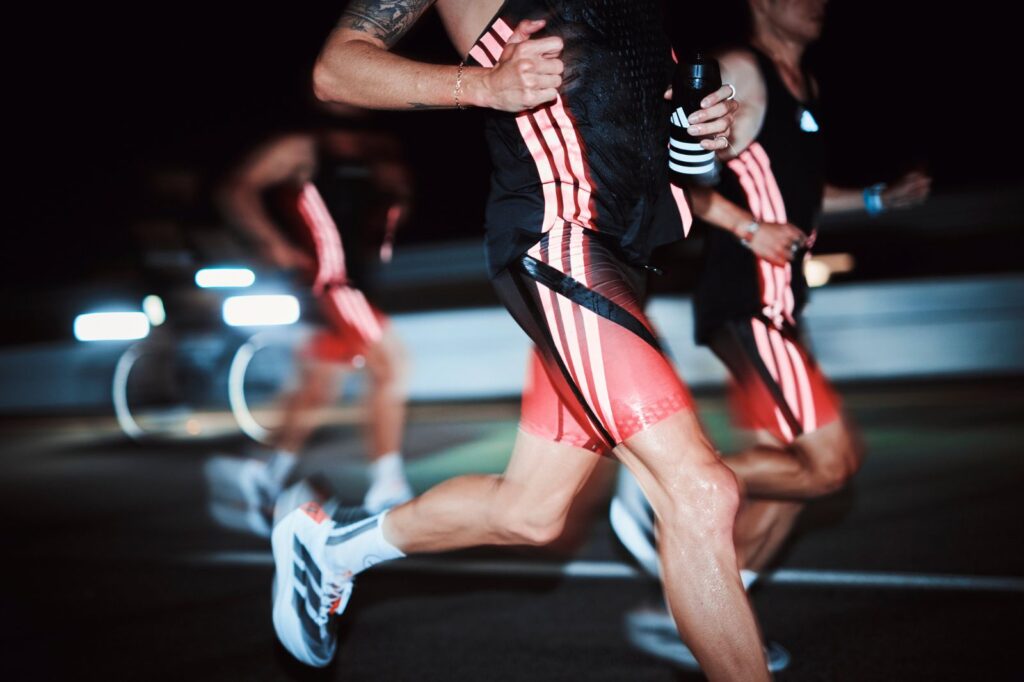
Racing in the newest gear (photo courtesy of Adidas)
The clock hit 5:59:00, and we could see the drone at a distance. Then Sibusiso Kubheka and his pacer appeared. Everyone started to cheer, then someone yelled, “He is going to make it!” Literally, everyone loses their shit. The cameras are quickly set in front of the finish line. Everyone is confused about what is allowed, but in the chaos, nobody cares. We quick-walk closer to the action. I pull out my phone and capture what I can of the epic finish!
Sibusiso crosses the line at 5:59:20 and immediately goes to the floor. Everyone is going crazy; the emotion is real. He made it; the team won. Behind me, someone yells in Italian at the top of his lungs, “One hundred kilometers! One hundred kilometers!“
I could only think one thought: I love running.
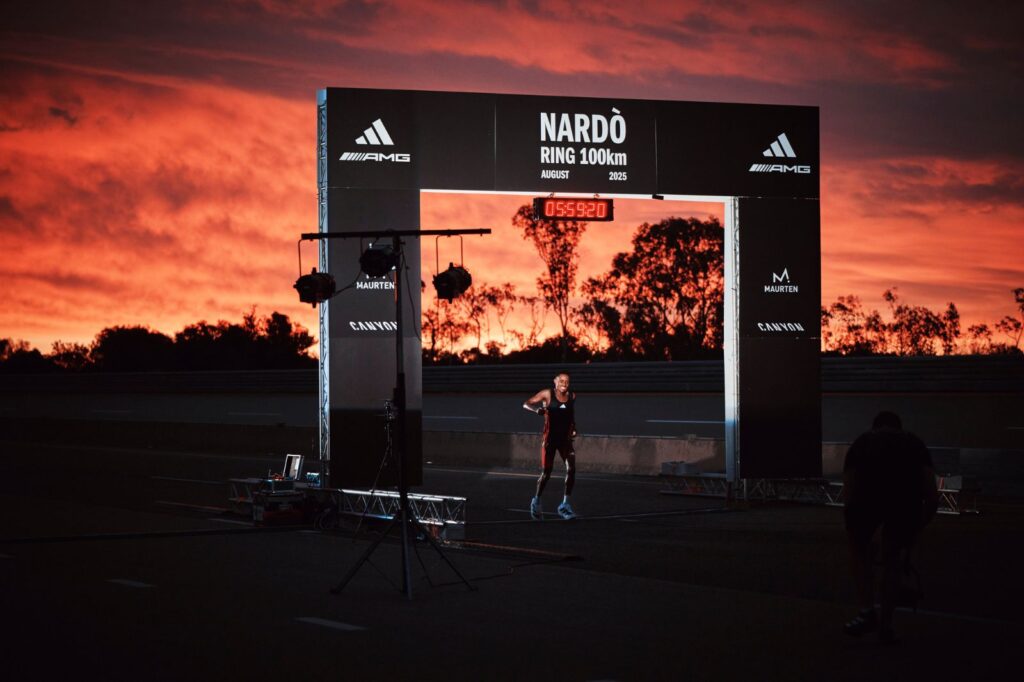
Sibusiso Kubheka crossing the finish line under 6 hours (photo courtesy of Adidas)
Not all of them ran under 6 hours, but each finisher broke the previous world record. Sibusiso Kubheka, the man who conquered the challenge, gave it all, and after a quick photo with South Africa’s flag, he collapsed to the ground again.
Charli Lawrence arrived at 6:03:47, and everyone was ecstatic. He knew it was a great time, but still not under 6. He went to the team to say hello and simply said, “Sorry.” His right shoe was full of blood at the ankle. He still walked around and congratulated Sibusiso.
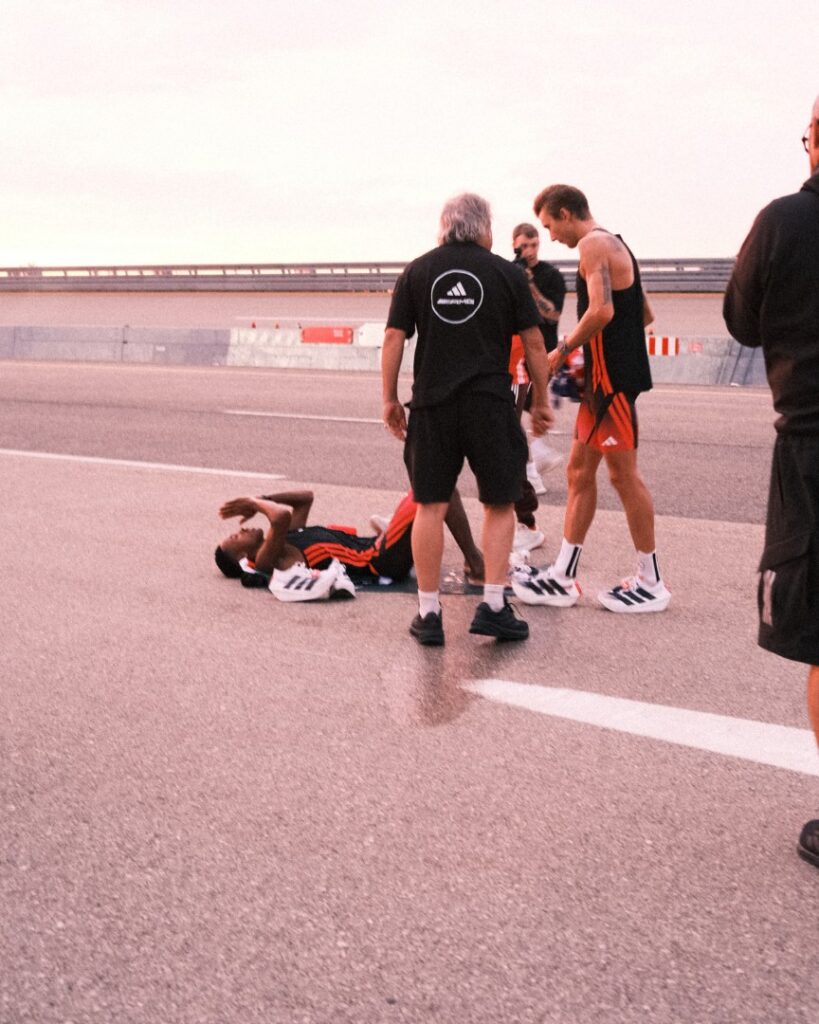
Sibusiso Kubheka collapses on the ground (photo courtesy of Believe in the Run)
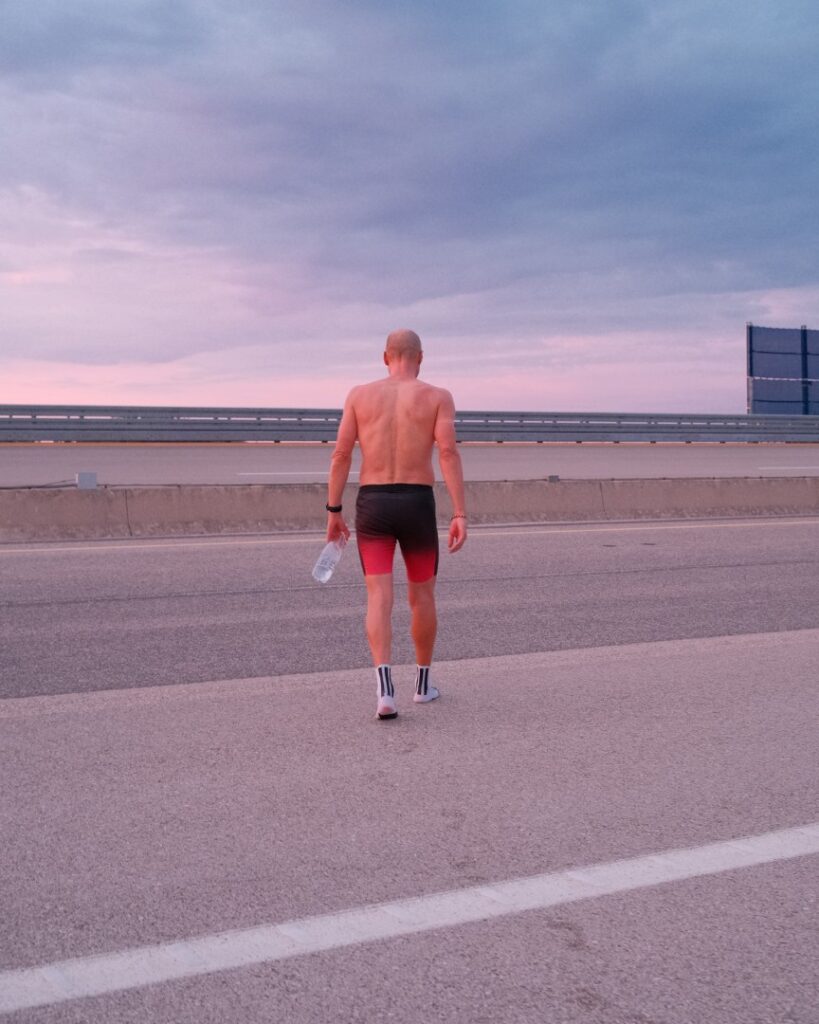
Aleksandr Sorokin takes a moment alone (photo courtesy of Believe in the Run)
When Aleksandr Sorokin crossed the finish line at 6:04:10, he had broken his own world record. But now it was not enough. His arrival was very emotional; after crossing, he went directly to congratulate Sibusiso, then hugged someone from his team, took off his shoes, and walked barefoot away from us. Not saying a word, just breathing, reflecting on the effort. After a couple of minutes, he approached the cameras, smiling again and enjoying the moment, even making jokes.
Although everyone worked hard to achieve this record, nobody was expecting the perfect and emotional outcome. Beyond the company goals, it felt like a real team effort, a successful test. For me, it was an unforgettable experience. I was there, I saw it with my own eyes, the ones that I could barely keep open.
But now I need to take a nap.
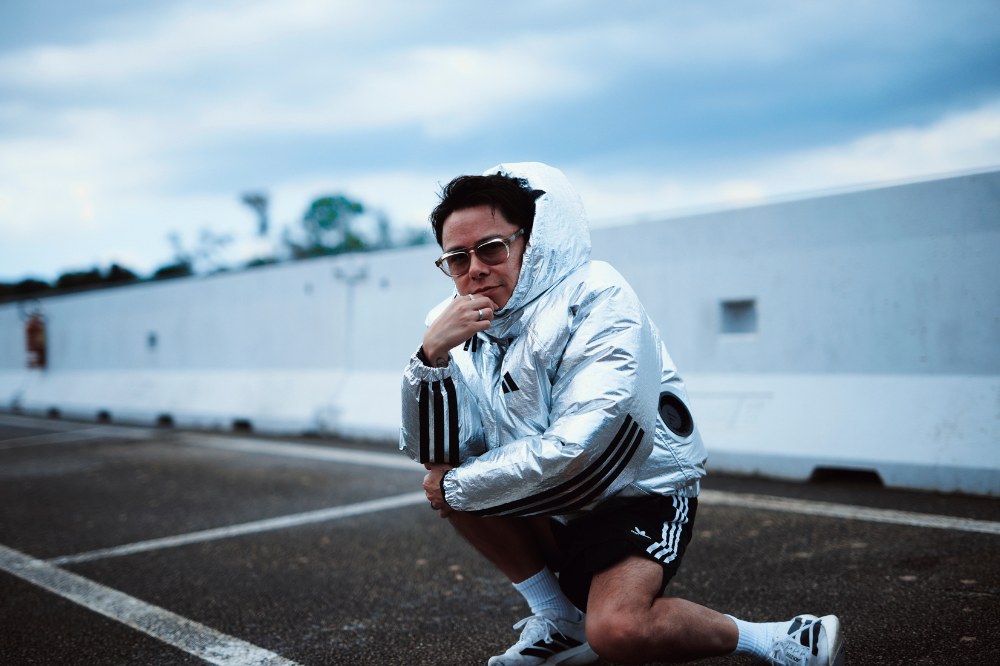
Testing out the Climacool jacket for myself
Have something to say? Leave a Comment

Alfredo is a runner, writer, creative director, and cultural analyst based in Berlin. After years as a casual runner, his move to Berlin transformed his running into a vital practice for mental health and a source of tranquility during cold, early morning runs. His interest in clothes comes from uniforms and sportswear, combined with a love for innovation and research—which might explain why he meticulously charts his winter running gear.
More from Alfredo